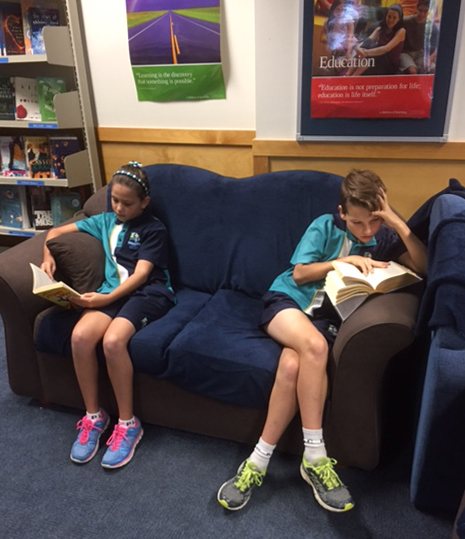Issue 99
Term 4 2016
Stopping the slide: improving reading rates in the middle school
After noticing a drop in borrowing rates as students entered the middle school, Narelle Keen gathered data and conducted student interviews to understand why. Narelle proposes recommendations to improve borrowing rates.
At each end-of-year assembly, I give out our Champion Reader Award to students in the junior college who have borrowed more than 120 books throughout the year, and to students in the middle and senior college who have borrowed more than 50 books. In our junior college, we always have large numbers of students who meet the qualifying mark; however, we often struggle to have a dozen of the older students receiving awards.
For years, I had a general sense that borrowing rates dropped off as students entered the middle college, and in my 2015 annual report, I decided to look at the figures and quantify them. I compared the borrowing figures for our Year 6 cohort in 2015 to the borrowing figures for the same students in 2014. The results indicated a greater decline than we had realised.
Fifty-three students attended the school in both years. In Year 5, the average borrowing rate was 56.8 books per student; however by Year 6 — the first year of middle school — that number had fallen to 16.5 books per student. Of course, these figures do not take into account books borrowed from public libraries or from friends, or books that students had bought or received from family. However, the significant drop in numbers was concerning enough that it needed to be addressed.
I took my findings to a meeting with the English department, and discussed them in my annual review with our principal. Anecdotal evidence suggested that reading rates were dropping as students progressed into higher grades, but this was the first time we had hard data to support this. After consulting with these stakeholders and the Year 6 teachers, I decided to investigate the causes and provide recommendations as part of my professional learning. With the approval of our principal, I proposed the following process:

- Identify objectives for this project, and their measurement for success.
- Send out a student survey using SurveyMonkey.
- Conduct follow-up interviews with students.
- Analyse the results to see where improvements can be made.
- Identify solutions, and implement the changes.
- Review at the end of the year to determine the success of the project.
Not only do we hope to see an increase in our borrowing statistics at the end of the year, we also hope to maintain this increase as the student cohort progresses through the college. Other success criteria are more nebulous and difficult to measure, but include seeing students more engaged and enthusiastic about reading.
To make the survey and interviews more manageable, we only surveyed the first 20 students on the list.
Survey results
The interviews indicated that most students did not have an accurate idea of how much time they spent reading or how much their borrowing had decreased. Only one-quarter of the students recognised that their borrowing had decreased significantly and, interestingly, seven students thought their borrowing had increased. None of them were able to explain how they had formed this opinion, and were surprised to see that the data contradicted it.
Most students were keen to spend more time reading; some even lamented that they were no longer read aloud to in class like they were in junior college. The majority identified an increased workload and more extra-curricular activities as reading barriers. Worryingly, three-quarters said that they couldn’t find books they were interested in. Our collection is fairly modern, but it is cramped, with no room to expand, and middle and senior college books are inter-shelved. (Our middle college students are not permitted to read senior fiction without a note from home.) Despite all of our front-facing books, displays, and the use of genre stickers, students said in their interviews that they found it difficult to find the books they wanted, and that they wanted more copies of popular titles.
Six students commented that they preferred to borrow books from the public library or to purchase the book themselves. Reasons included a preference for a bigger selection and longer loan period at the public library, and, for those in the latter category, the desire to own the book themselves.
Our middle school has a Bring Your Own Device (BYOD) program, which means iPads are introduced into the classroom in Year 6. Although half of the respondents believed that the introduction of the iPad did not impact the amount of time they spent reading, anecdotal evidence from teachers suggested otherwise. The Year 6 borrowing rate in 2012, the year before we introduced iPads in the school, was 32 books per student. In 2013, the first year of the iPad trial, that figure dropped to nine books per student. Since then, numbers have recovered slightly, but not to the level they once were: in 2014, the borrowing rate was 17 books per student, and 13 books per student in 2015. Admittedly, these figures represent different cohorts of students, but it does suggest a correlation between the introduction of iPads and less time spent reading.

Although most students understood that reading would benefit their academic results, few could articulate what those benefits were, or how reading might benefit them in other areas.
How can we improve reading rates?
After analysing the results of the survey and interviews, the following recommendations were made:
- Revise the Year 6 library program to include a wide reading focus and to provide extra time for students to read. Establish a routine around borrowing and silent reading, and clearly communicate reading expectations to students.
- Help students understand the benefits of reading by highlighting current research showing the myriad advantages of reading — not only academically, but socially and physically as well. Infographics are a great way to present this information in a clear and concise way. An example of useful infographics can be found here.
- In conjunction with the Year 6 teachers, encourage students to borrow at least one book each week, with Year 6 teachers providing more opportunities for reading time in their busy schedule.
- Students to keep an online reading journal so that they have a more accurate understanding of how much they are reading. This will hopefully evolve into an online forum where students can discuss and recommend books.
- Separate the middle and senior collections to make age-appropriate books easier to find, creating a separate middle college library identity. We are fortunate to be getting a library extension next year, approximately two classrooms in size, which will give us the required space to do this.
- As far as our budget will allow, purchase multiple copies of popular titles to increase availability.
- Purchase more magazine titles, as students indicated that they enjoyed reading them.
The recommendations above are currently being implemented, with the exception of separating the two collections, which will happen next year when we get our library extension.
Where to next?
At the end of the year, I will run our borrowing statistics report again to see if these changes have impacted borrowing rates. If not, we will undertake further surveys, interviews, and reviews to lead to improved reading programs.
Many factors affect student borrowing, some of which are beyond the control of the teacher librarian. However, anything that we can do to make borrowing easier and more attractive to students will benefit not only the students, but the library as well. Having access to hard data has been invaluable in informing this project, and in receiving support from key stakeholders to implement new reading programs.
Image credits:
- 'Reading the book' by kaboompics.com. Licence at http://creativecommons.org/licenses/by/2.0.
- Students reading. Photo supplied by Narelle Keen.
